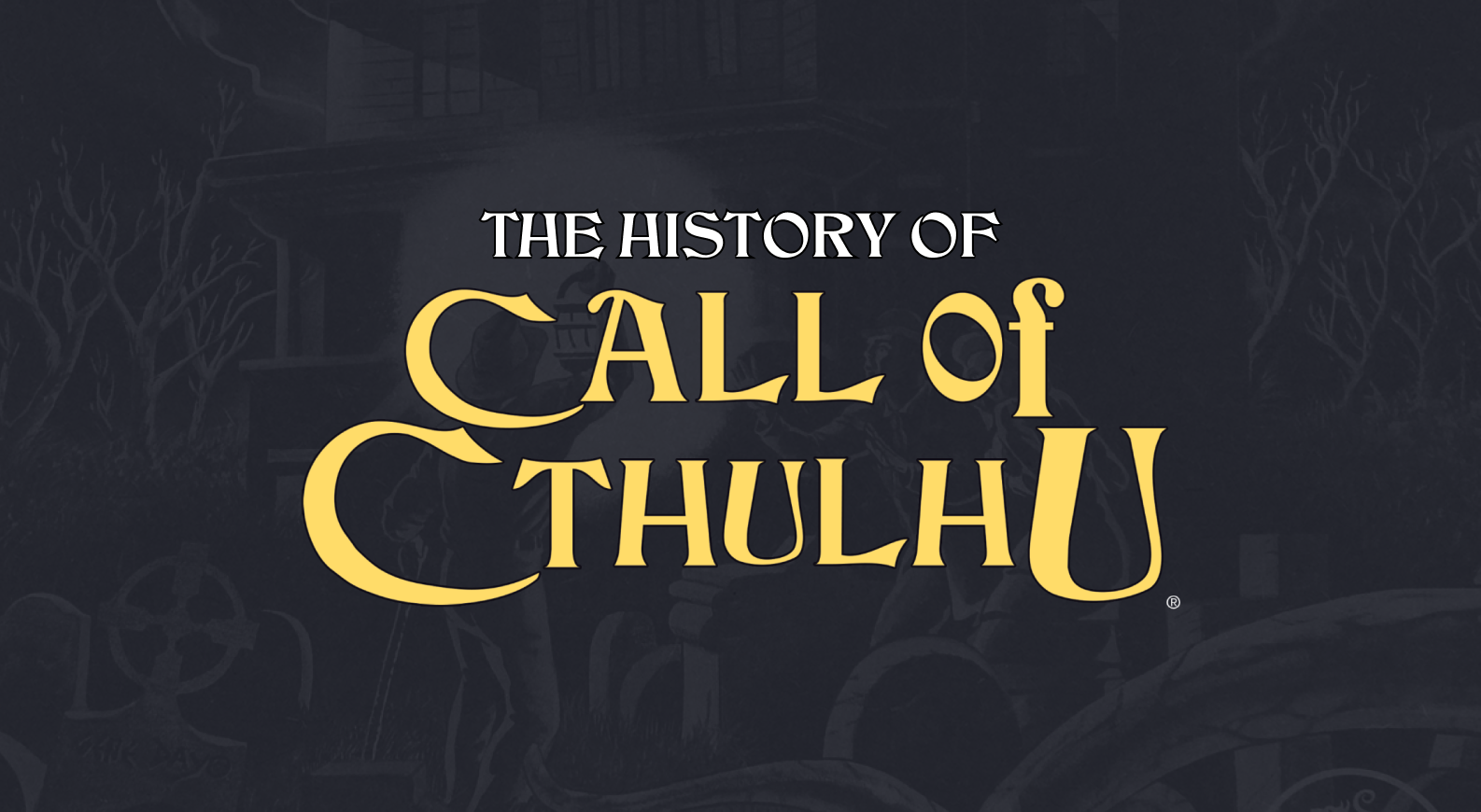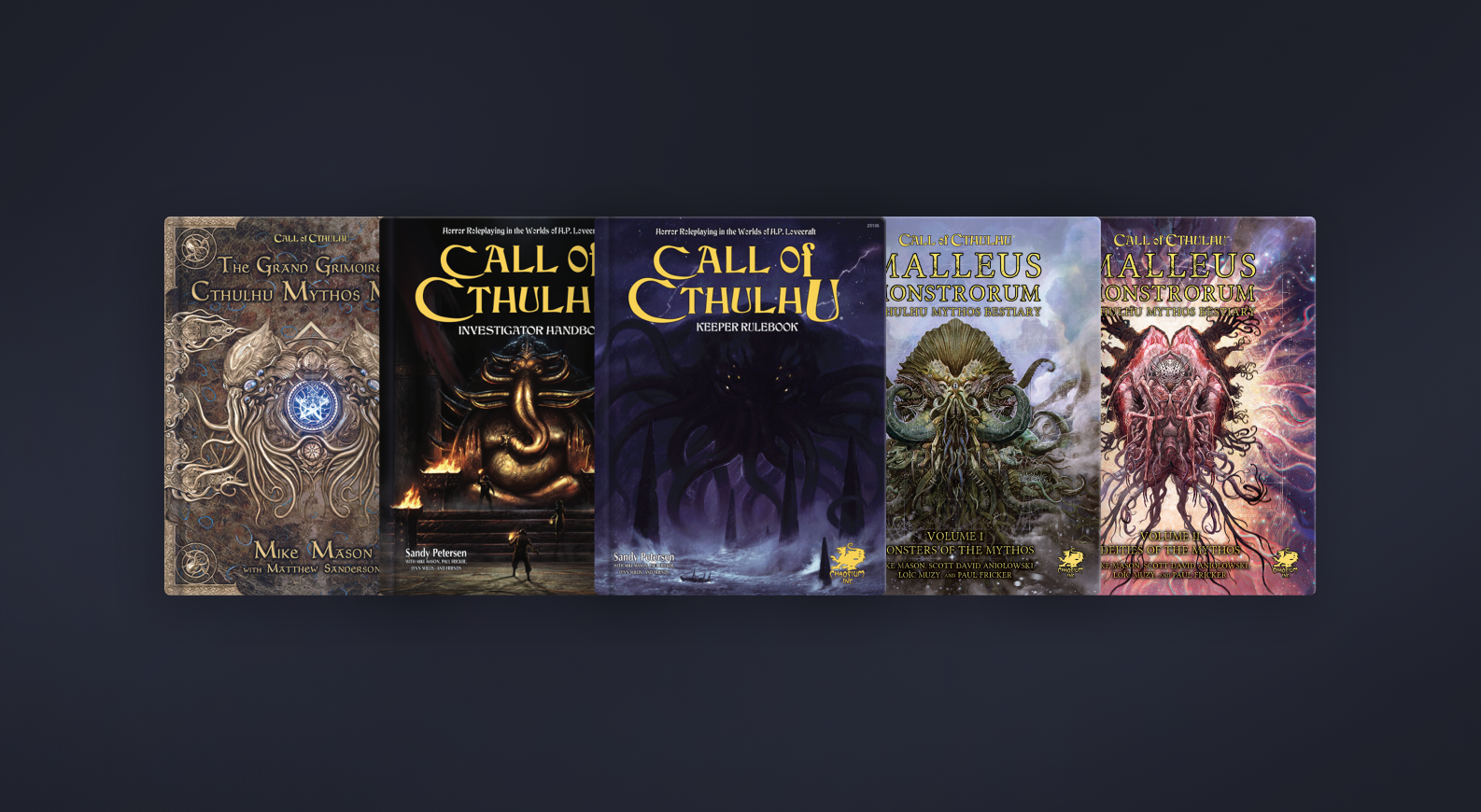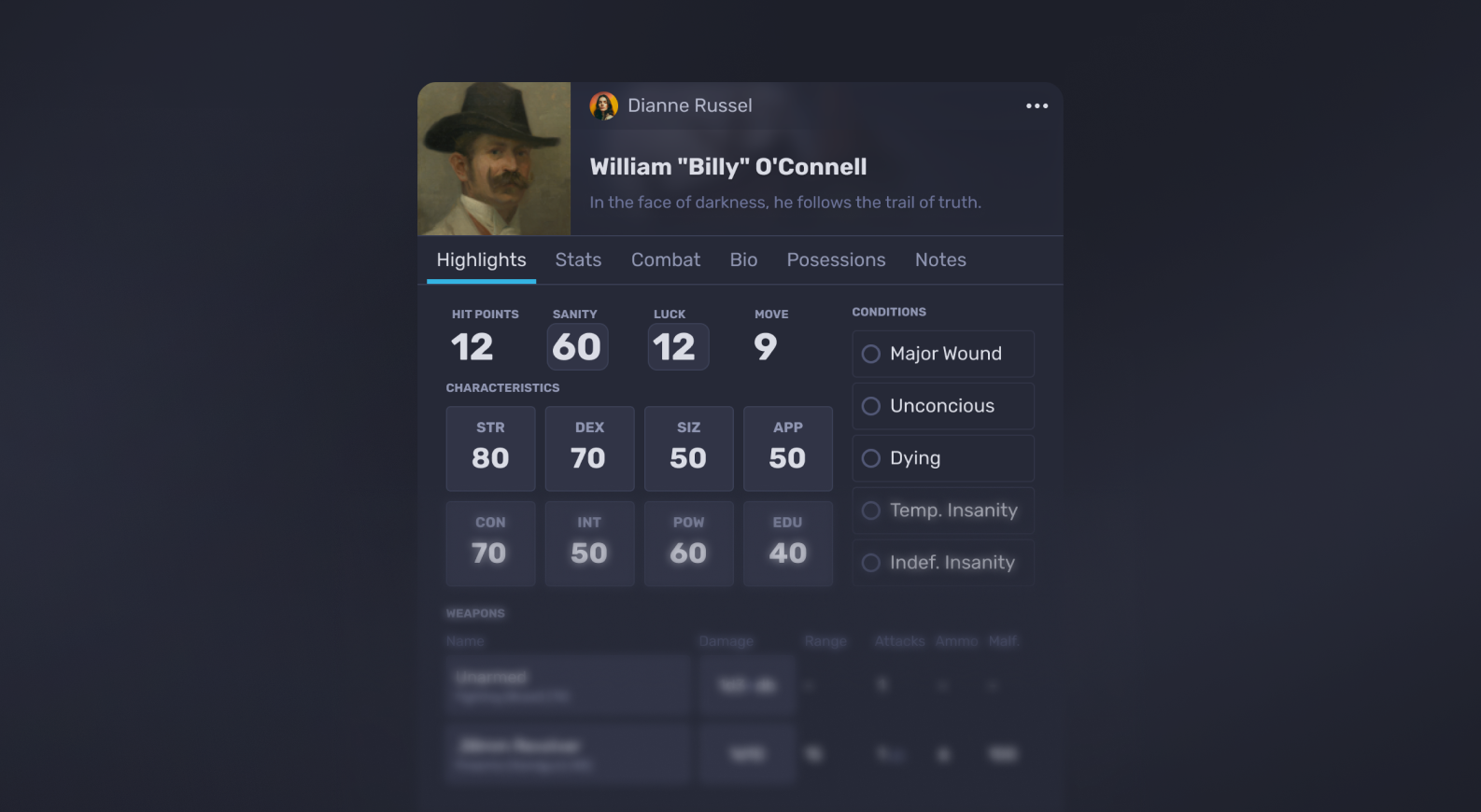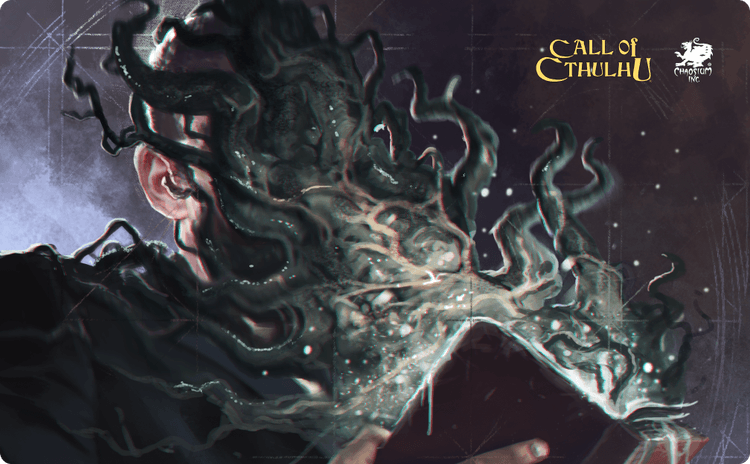Jump to section

Thorsteinn Mar
Feb 22, 2024 · 23 min read
The History of Call of Cthulhu

Four decades of unfathomable horror
A few years after I began playing roleplaying games, I was introduced to the Call of Cthulhu roleplaying game by Chaosium. I immediately fell in love with the game and have played it for over 30 years. I have played through countless homemade modules and published campaigns, and my 5th edition rulebook has seen more use than any other rulebook I own. It is safe to say that it is almost at the end of its life, with only a few hit points remaining.
I have often wondered what my gaming experience would have been like if I had never discovered Call of Cthulhu. It is hard to imagine that the game, as we know it today, could have easily never existed. However, as I delve deeper into the history of Call of Cthulhu, I have come to appreciate it more and more.
Based on the works of H.P. Lovecraft, a highly influential American author in the early 1900s, Call of Cthulhu draws from a collection of horror stories known as the Cthulhu Mythos. Lovecraft and other authors such as Clark Ashton Smith, August Derleth, and Robert E. Howard wrote tales of horror that often included cosmic dread and unnamable creatures that sought to destroy humanity or drive it insane.
H. P. Lovecraft and his influence
H.P. Lovecraft was a prolific writer and wrote over 100 short stories and novellas during his lifetime. Some of his most famous works include Call of Cthulhu, Shadow out of Time, Shadow over Innsmouth, and At the Mountains of Madness. Lovecraft's writing has had a significant impact on modern authors such as Stephen King, Michel Houellebecq, Alan Moore, and Neil Gaiman. His influence can also be seen in films, computer games, and music, such as Metallica's song Call of Ktulu. In fact, Pathfinder's publisher, Paizo, heavily references Lovecraft's works, both directly and indirectly.
The Cthulhu Mythos, which is probably the most used and overused part of Lovecraft's works, was not solely his creation. Many authors, including Clark Ashton Smith and Robert E. Howard, contributed to the Cthulhu Mythos and were often referred to as the Lovecraft circle. Therefore, many of the Mythos creatures are not Lovecraft's creations, such as the Yellow King or Tsathoggua.
Lovecraft's works can be divided into three categories: Dunsanian, Arkham, and Cthulhu. His Dunsanian work was mostly fantastical and written in a style similar to Lord Dunsany's. Lovecraft's Dreamland stories fall into this category. The Arkham stories take place in his fictional New England setting, with stories like The Silver Key and Herbert West – Reanimator belonging to this category. The final category, Cthulhu, describes the stories of unfathomable cosmic horrors, where alien monsters and cosmic dread are all-encompassing.
True to Lovecraft or true to Cthulhu?
I can't help but wonder how true to Lovecraft's original work the many games published based on his stories really are. With dozens of board games, video games, and roleplaying games available, it's hard to know how much of the original content is being preserved while still injecting originality into each game. Additionally, many of these games only seem to focus on the Cthulhu part of Lovecraft's work, rather than the broader range of his stories. Chaosium is one company that has been faithful to presenting a wide range of Lovecraft's works in their games.
For Lovecraft, the Cthulhu Mythos was a collaborative setting that he helped create and that his friends in the Lovecraft Circle could add to. Even when ghostwriting, Lovecraft would include references to the mythos, and other writers, such as Robert E. Howard, would mention the Necronomicon in their stories. It's easy to imagine that the mythos was something to play around with, and Lovecraft himself humorously referred to it as "Yog Sothothery".
It’s full of stars!
Lovecraft's works are centred around the discovery of something horrible, so alien and mind-boggling that it changes the reader's perception of the world forever. If you read through his stories, you'll find that almost all of them revolve around this theme, regardless of their specific plotlines. The author makes this clear even in the opening paragraph of the short story Call of Cthulhu.
Lovecraft's works primarily focused on characters who stumble upon some horrifying discovery that threatens their sanity. Although he never wrote about a person armed with a tommy-gun being chased by mad cultists or a special force fighting mythological creatures, the Cthulhu Mythos has become a mainstream cultural phenomenon due to TV series like Stranger Things and True Detective.
It's tempting for game masters to use this to attract players, but simply adding Cthulhu, Nyarlathotep, or Yog-Sothoth to a setting doesn't make it Lovecraftian. More elements are needed to create an authentic Lovecraftian setting.
Dark Worlds
The year 1978 saw the publication of RuneQuest, a roleplaying game by Greg Stafford, by Chaosium. The game enjoyed some success, which encouraged Chaosium, previously known for only publishing wargames such as White Bear and Red Moon, which many Glorantha fans might know or have heard of, to publish more roleplaying games.
Around 1979, Steve Lortz and his brother Kurt came up with the idea of creating a roleplaying game based on the works of H. P. Lovecraft. Steve had previously worked with Chaosium, having created a few smaller games, such as Panzer Pranks, published by Chaosium.
He pitched the idea for the game to Greg Stafford, who was interested. Steve was also in touch with Arkham House, the owner of the publishing rights of Lovecraft, August Derleth, and many other Mythos authors. Although Arkham House had never worked with game publishers before, they were interested in hearing Lortz's proposal.
Initially, Steve's game was called Dark Worlds. Chaosium acquired the gaming rights to Lovecraft's works, and Kurt, along with Steve and a group of friends, set out to develop the game. The Lortz brothers built a game system from scratch, and even though it was not fully developed, a manuscript of over 200 pages was presented to Chaosium and sent to a few staff members to read.
It's worth noting that this early game was nothing like the game we know today as Call of Cthulhu. It was not based on the same system as RuneQuest, and even the approach to the Cthulhu Mythos was different from what Chaosium ultimately decided. According to Rick Meints, President of Chaosium, the game was so different from anything they had ever published that we would not recognize it as a Chaosium game!
Dark Worlds abandoned
In the early 1980s, Steve Lortz sent the first draft Dark Worlds to Chaosium. Lynn Willis, the rules editor at Chaosium, reviewed the game and requested Steve to align it more with RuneQuest, which was a popular game at the time. RuneQuest had a simplified version of rules called Basic RuneQuest (which later would turn into BRP or Basic Role-Playing), which Chaosium wanted to use for Dark Worlds.
Steve, however, was not comfortable with this idea and conveyed to Chaosium that it would require significant rewrites and delay the project. He also suggested expanding the game beyond Lovecraftian elements and including options for characters to be vampire hunters and people fighting the Frankenstein monster.
While Steve continued working on Dark Worlds, Sandy Petersen approached Chaosium with the idea of creating a Lovecraft-focused game using the BRP rules. Initially, he proposed a game called RuneQuest Cthulhu, which was eventually changed to Call of Cthulhu. As a result, Steve's Dark Worlds was shelved, and Call of Cthulhu became a huge success.
Call of Cthulhu roleplaying game
Call of Cthulhu is a tabletop roleplaying game that was first released in 1981. It has since undergone six renewals and many updates, with licensed foreign language versions also available. Sandy Petersen created the game, using the newly published Basic Role-Playing (BRP) rules as a core mechanic and adding special rules for the horror genre, including mechanics for sanity and luck.
Initially, the game was published as a boxed set, which included a 16-page rules booklet for BRP. The cover art was created by Gene Day. In many ways, the game was different from other tabletop games of the time, as players took on the roles of investigators who followed clues, rather than invading dungeons or tombs in search of treasure and monsters. The game also made it clear that investigators would not necessarily survive, instead risking either death or insanity as they uncovered more clues and encountered the horrors of the cosmic world around them.
Shadows of Yog-Sothoth
The first book of Call of Cthulhu adventures was Shadows of Yog-Sothoth. It was a 72-page softcover book that was written by Sandy Petersen and a few other authors. The cover art was done by Tom Sullivan. The plot of the book is about a secret cult, the Hermetic Order of the Silver Twilight, that plans to destroy mankind. The characters encounter this cult in the United States but have to stop it in other parts of the world, too.
The format of this module was used in many subsequent campaigns such as Fungi from Yuggoth (later known as Curse of Cthulhu and Day of the Beast), Spawn of Azathoth, and possibly the most highly acclaimed, Masks of Nyarlathotep. Shadows of Yog-Sothoth is important because it represents the first published addition to the boxed 1st edition of Call of Cthulhu.
This type of roleplaying module defined a new way of approaching a campaign of linked scenarios. It involves actual clues for the players to follow and link together to uncover the dastardly plots of cults and madmen. Since then, this format has been used in many modules, not only for Call of Cthulhu but also for other games as well; for example the Adventure Paths by Paizo for Pathfinder have much in common with this format.
New editions
Call of Cthulhu was updated regularly until 1992, with new editions being published. The 2nd edition, released in 1982 (only six months after the 1st edition), was a boxed set that contained one 96-page rulebook, referred to by many as Cthulhu Classic. It included a few updates and tweaks to the rules. The 3rd edition, released in collaboration with Games Workshop, was published in 1986. The 4th edition, published in 1989, was a softcover that included much more content than the first three editions' rulebooks.
During this time, Sandy Petersen not only developed and updated the rules of Call of Cthulhu but also co-developed the Ghostbusters roleplaying game with Lynn Willis and Greg Stafford. This game was the first to introduce dice pool mechanics and was later further developed by West End Games for the Star Wars Roleplaying Game.
The 5th edition, published in 1992, was a softcover that credited Lynn Willis as a co-creator for the first time. Willis made a few updates to the rules in the 90s, but the 6th edition was released in 2004. Due to illness, Willis, the longest-serving employee at Chaosium, left the company but passed away in 2014. Mike Mason became Call of Cthulhu line editor in 2013 and continued its development with Paul Fricker. Together, they made the most significant rule alterations than in any previous edition, culminating in the release of the 7th edition in 2014.
The game system changes have always been incremental rather than radical overhauls, making it easy to adapt old sourcebooks and modules to the latest version of the game. Even the latest edition has a few pages at the back of the Keeper's Book with guidelines on how to update such content to the 7th edition. In my opinion, this is something that other publishers might learn from.
Sandy Petersen leaves Chaosium
Sandy Petersen, the developer of Call of Cthulhu, also showed interest in computer games. In the late 80s, he worked on his first computer game, Sid Meier's Pirates!. Throughout the 90s, he worked on multiple video games such as Doom, Civilization, Age of Empires, and Quake.
Sandy Petersen rejoined Chaosium in 2015, along with Greg Stafford, but retired from the board in 2019. Currently, he runs Petersen Games, which publishes both roleplaying games and board games.
Financial troubles
In the late 1990s, Chaosium faced financial difficulties as the roleplaying games market declined due to the increasing popularity of computer games. This hit Chaosium hard and many roleplaying games publishers, including West End Games, faced similar problems and some even went bankrupt. Even TSR was affected and was eventually saved from bankruptcy by Wizards of the Coast.
As a result, Chaosium had to stop producing the Mythos Collectible Card Game and the release of Call of Cthulhu sourcebooks became sporadic and difficult. However, in the '00s the company gained some momentum and managed to release the 6th edition in 2004. The year 2005 was one of the busiest years in the company's history, with the release of 10 different books for Call of Cthulhu, including Cthulhu Dark Ages, Secrets of Japan, and Secrets of Kenya.
Great Campaigns for Call of Cthulhu
Call of Cthulhu boasts of many great campaigns published by Chaosium which make the game one of the best. Among these campaigns, Masks of Nyarlatothep stands out and is considered to be one of the best roleplaying campaigns ever published. The Horror on the Orient Express is another great campaign. Initially released in 1991 as a small boxed set, the staff at Chaosium nicknamed this edition the cigarette-box edition as the box was so fragile that they had to print three times as many boxes as books.
Beyond the Mountains of Madness is yet another excellent campaign which was released in August 1999. The narrative is a sequel to At the Mountains of Madness, which is considered one of the best stories by Lovecraft. The book is massive, over 400 pages long, but the campaign is great. The book has been out of print for some years, but Chaosium plans to reprint it and make it available again.
These campaigns stand out for their overall consistency of the setting, which requires minimal suspension of disbelief. In many roleplaying game narratives, players use suspension of disbelief to accept the fact that their characters can do things within the game system and setting that are not possible in real life. However, in some narratives, the player must also suspend their belief when it comes to the overall consistency of the setting.
Kickstarter successes and failures
Chaosium launched a Kickstarter campaign in 2013 for The Horror on the Orient Express, a game campaign that had been a fan favorite since its original release in 1991. The Kickstarter campaign was a huge success, raising over $200,000. The company went above and beyond by offering numerous stretch goals, which made the package quite heavy, but the fans were thrilled.
A few months later, Chaosium launched another Kickstarter campaign for the 7th edition of Call of Cthulhu, which was even more successful, raising over half a million dollars. Once again, the company promised many stretch goals, which made it difficult to fulfill.
At the time, Charlie Krank was the CEO of Chaosium. However, the company failed to deliver the new edition on time due to poor management and bad business decisions. After repeated delays, it was clear that the developer was struggling, and a change was needed. Therefore, Greg Stafford, Chaosium's founder, returned to the company, and Krank was fired. Greg brought Sandy Petersen with him. With only a few thousand dollars left in the accounts, they, along with the great team at Moon Design Publication, managed to get the 7th edition released, which was more or less paid by themselves.
Call of Cthulhu 7th Edition

Call of Cthulhu's 7th Edition, developed by Mike Mason and Paul Fricker, has been widely praised by both experienced and new roleplayers alike, with sales surpassing all previous versions, according to Rick Meints.
The Lightless Beacon, a fantastic adventure included in the starter set, has been particularly popular and has attracted many new players to the game.
The Character Sheets have been updated, and new rules, such as those for chases, have been introduced. While some fans were initially concerned that the game's overall tone had shifted from being an investigative roleplaying game to a more action-oriented one, Rick Meints points out that most of the changes, including the rules on chases, are optional.

The Keeper Rulebook is an impressive 447 pages compared to the 96 pages of the Cthulhu Classic rulebook. The 3rd edition hardcover book was over 190 pages long, and the 5th edition was over 240 pages long. As the game has evolved over the years, fans have requested more information, including a greater variety of tomes and more details on the 1920s setting.
However, the size of the rulebook is not the only consideration. Every RPG publisher aims to strike the perfect balance between the length of the book, its price, and customer satisfaction. Most rulebooks today are priced at around $50-$60 and average around 250 pages. Even when a rulebook is much longer, like the Keeper Rulebook, it does not cost much more.
Cthulhu is still calling!
H.P. Lovecraft remains an influential figure, almost 90 years after his death, not only in literature but also in roleplaying games. Chaosium was almost the sole publisher of games based on H.P. Lovecraft’s fiction for many years. However, the number of roleplaying games that refer to his Cthulhu Mythos has exploded in recent years. References to Lovecraft can even be found in D&D games (such as Rime of the Frostmaiden, with Kingsport, the giant albino penguin, and Tekeli-Li, the gnoll vampire.)
A few years ago, Lovecraft’s work became public domain in the EU, but the copyright for his work in the US is a minefield due to complicated copyright laws and Chaosium's trademarks on “Arkham Horror” and “Call of Cthulhu“. Arkham House owns the copyrights to a whole bunch of Cthulhu mythos material and claims to have the copyrights to H.P. Lovecraft’s work. Additionally, Chaosium owns the copyright to much of what many Lovecraft fans believe to be his work, such as the image of the Elder Sign, which was actually drawn for Chaosium publications.
Over the course of four decades, things and perspectives have changed. Although Lovecraft was a known racist and far out of touch with the social attitudes of the time, Chaosium has never supported his views or promoted them in any way. However, they do recognize his flaws and draw attention to them. They encourage us, the gamers, to appreciate those parts of his work where his strengths as an author shine through, such as his vivid imagination and worlds of ancient mystery.
The Stars are Right!
The Call of Cthulhu roleplaying game is currently experiencing a surge in popularity, with new players eager to join in on the fun. This is largely due to Greg Stafford's decision to bring Moon Design Publishing to Chaosium, which has proven to be a good move for the company.
Getting started with Call of Cthulhu has never been easier, whether you're playing with friends or trying out the many solo adventures available on Chaosium.com. You could even find a group online and use Quest Portal for a frictionless experience. However, you should act fast, as "In his house at R'lyeh, dead Cthulhu waits dreaming."
I would like to express my gratitude to Rick Meints for his help and insightful information.
